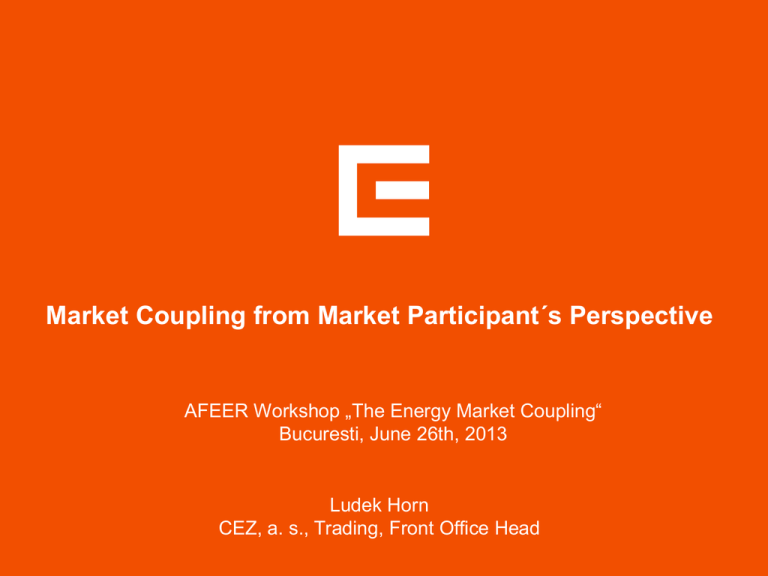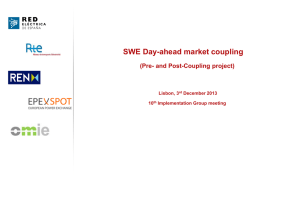Market Coupling from Market Participant´s Perspective
advertisement

Market Coupling from Market Participant´s Perspective AFEER Workshop „The Energy Market Coupling“ Bucuresti, June 26th, 2013 Ludek Horn CEZ, a. s., Trading, Front Office Head MARKET PARTICIPANTS HAVE DIFFERENT INTERESTS End consumers want to cover their expected consumption for minimum price Consumer c Example of off-take diagram Power Exchanges and Broker Platforms have similar function as traders Import Trader 2 Trader 1 Power Exchange Export Traders match contradictory interests of consumers end producers by means of taking open positions Generator 1 Generator 2 Example of annual availability Generators want to maximize income from utilization of availability 1 HOW MARKET COUPLING COUPLES ALREADY COUPLED MARKETS? You already know… Market Coupling combine demand and supply curves of spot exchanges of coupled markets. Market Coupling is based on the implicit allocation of cross border capacities by TSO to spot exchanges Merit Order trhu A €/MWh Merit Order trhu B €/MWh Cross Border Capacity MW MW WHAT MARKET COUPLING BRINGS And what takes away… Before… TSO allocates cross border capacity to market participants in Day-1„for tomorrow“ in the auction Market participant based on allocated cross border capacity performs export or import (scheduling…) Market participants move power across borders „Explicit“ allocation of cross border capacities I After... TSO allocates the same cross border capacity to spot exchanges in Day-1„for tomorrow“ Spot exchanges based on bids and asks for electricity perform export or import (shipping…) Spot exchanges move power across borders „Implicit“ allocation of cross border capacities Note: Market participants continue moving power cross border based on annual or monthly capacities WHAT MARKET COUPLING BRINGS And what takes away… II Elimination of an explicit cross border capacity allocation leeds to: • Decrease of spot trader´s headache (but also elimination of cross border trading…) • Reduction of market participants operational risk • Elimination of gaming potential of explicit allocation • Elimination of spot exchange gate closure sequence problem (having closure at the same • time) Harmonization of spot market rules • • • • Substantial increase of spot market liquidity (and thus to more robust price index) Decrease of price spreads between coupled markets Decrease of volatility of coupled markets Power flows from the cheaper market to the mor expensive market (not all the time with FB) Overall increase of market efficiency 4 DO NOT BELIEVE IN MARKET COUPLING MYTHS! There are 3 myths… True or false: Market Coupling increases price of electricity. False, because Market Coupling does not come out of the blue – there is a cross border trading before market coupling. In case the cross border capacity is the same in both cases, the prices will be almost the same, just small change because of decreased price spread. True or false: Market Coupling means the same price in coupled markets. False, the same price in coupled markets is rather an exception than a rule. It happens usually when markets have similar power plant portfolio and/or very high cross border capacity. True or false: TSOs lose their income from cross border capacity auctions. False, TSOs´ income is the spread between electricity prices and is approximately the same as income from explicit auctions, just slightly decreased because of the spread decrease. 5 EFFET ON LIQUIDITY Example: CZ-SK Market Coupling Efektivnější/intenzivnejší využití přeshraniční kapacity Obecný nárůst obchodovaných objemů Relativní snížení cenového rozdílu mezi trhy Market Coupling mezi CZ-DK launched on Sep 1st, 2009 Apr May Jun Jul Aug Sep Oct Nov Dec CEZ VIEV ON MC DEVELOPMENT IN CEE/SEE CZ-SK-HU MC operational since September 11th, 2011 • good experience so far (higher liquidity, lower spreads) • coupling calculated in PCS infrastructure (Cosmos) somewhere in Paris/Leipzig = NWE ready • Poland and Romania recently expressed serious interest to join • extension by PL and RO based on Cosmos or Euphemia Final MC integration of CEE with NWE seems to get stuck • blind insistence on the CEE NRA Joint Declaration (MC+FB at the same time) • no progress in the project (TSOs waiting for NRAs decision) • Austria yet to nominate NOME • no clear leadership, no decisions (MoU not finalized) • unwillingness even to discuss crucial issues • timing dependent on NWE project progress 7 FLOW BASED ALOCATION AND MARKET COUPLING Current status: 1. FBA project in CEE is different from the CWE one and has not been proven feasible yet. 2. Problem with overlapping countries in different regions: • One country cannot be at the same time in two different MC initiatives (splitting of liquidity and other inefficiencies) – i.e. GE/AT in CWE, PL in NPS, SI with IT • NRAs treat borders in each region differently It is not efficient and wise to create an independent CEE MC solution Feasible and preferred solution: Add step by step CEE countries to the CWE ATC MC Wait for Single Flow Based with CWE 8 QUESTION AND ANSWERS Usefull links: · http://www.casc.eu/en/Resource-center/NWE http://www.epexspot.com/en/market-coupling/documentation_nwe http://apxgroup.com/services/market-coupling/nwe-price-coupling/ http://belpex.be/index.php?id=109 http://www.nordpoolspot.com/How-does-it-work/European-Integration/NWE/ THANK YOU FOR YOUR ATTENTION ludek.horn@cez.cz BACK UP Finding NEMO for DE-AT price zone Option 1 „ As it is“ (but the same gate closure…) EXAA Austrian Market EPEX Austrian Market Virtual Hub Austria in Cosmos Other AT borders with specific NTC EXAA German Market EPEX German Market NTC = ∞ Virtual Hub Germany in Cosmos Other DE borders with specific NTC 11 ELECTRICITY MARKET WORKS! But is distorted by subsidies for RES DESTRUCTING EFFECT OF RES ON WHOLESALE POWER PRICE Market Concept Is Systematically Disrorted Due to Increasing Portion of Subsidies to RES Impact of Growing Generation from RES on Wholesale Power Price Variable costs, €/MWh Demand Supported RES 100 generation brings volatile and less predictable supply Gas Hard coal Lignite 75 The spot prices decline (not the final price for the consumer!) damages non-RES generation 50 One more negative Nuclear impact – lower utilization of non-RES generation 25 RES 0 0 20 40 60 80 100 Available Capacity (GW) 13











